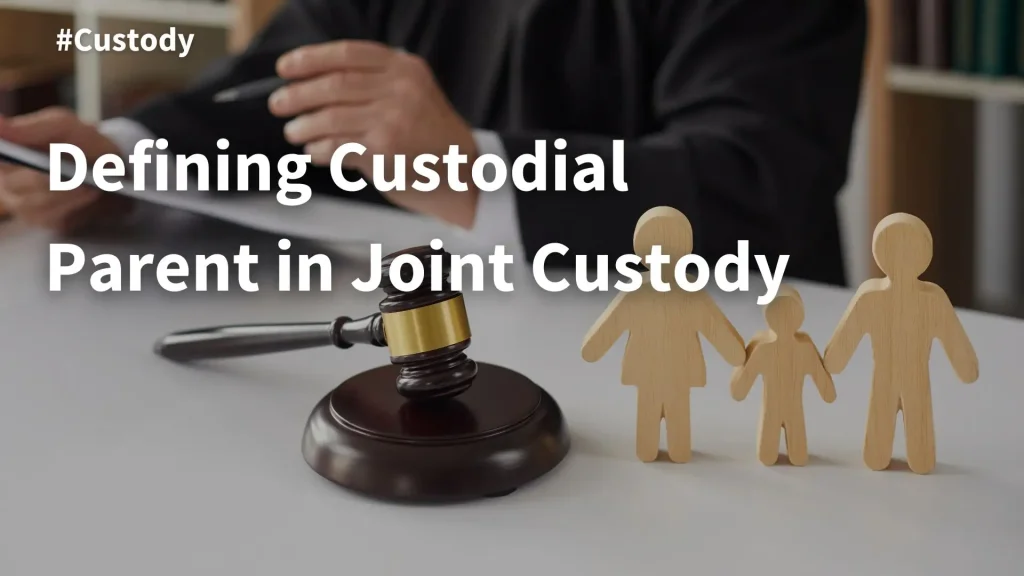When parents decide to separate or divorce, one of the most critical issues they face is determining child custody arrangements. In Texas law, “custody” is called “conservatorship.” If the parties have joint custody, they have a “joint conservatorship.” This means they share decision-making responsibility for the child. That doesn’t mean the child will split their time between parents. A possession order will identify each parent’s time with the child. Who is the custodial parent in joint custody?
In a joint conservatorship, one parent is usually the custodial parent, while the other is the non-custodial parent.
Who Is the Custodial Parent in Joint Custody?
In joint custody arrangements, both parents are responsible for raising their child. The custodial parent is the one with whom the child primarily resides. This parent is responsible for the day-to-day care and decision-making for the child. It’s important to note that the non-custodial parent also plays a significant role. They have visitation rights and may also have input into major decisions, depending on the specific terms of the custody agreement.
Custodial Parent Rights
According to Texas’s Office of the Attorney General, the custodial parent has the legal right to determine where the child will live. Custodial parents have several additional rights, including:
- Decision-Making – This capability typically encompasses the right to make everyday decisions regarding the child’s upbringing and general welfare.
- Child Support – This usually includes the right to receive child support from the non-custodial parent to help cover the child’s living expenses.
Non-Custodial Parent Rights
Under child custody laws, non-custodial parents also retain numerous rights, including:
- Visitation – This includes regular visitation time with their child, depending on the individual terms of the custody agreement. Even though the child may not live with the non-custodial parent, that parent has the right to know where their child is at any time.
- Input in Major Decisions – These decisions typically involve the child’s education and medical decisions. Unless modified by a court order, the non-custodial parent always has a right to give their perspective on critical decisions about their child’s life.
Joint Custody Arrangements
Joint custody arrangements, which include legal and physical custody, ensure that both parents play an active role in their child’s life. This type of custody emphasizes the importance of both parents contributing to the child’s development and well-being. When both parents have joint legal custody, they share responsibility for decisions concerning the child’s overall welfare, including:
- Education
- Healthcare
- Religious upbringing
Physical custody refers to where the child lives and the day-to-day care they receive. Joint physical custody aims to provide the child with a stable environment while maintaining strong relationships with both parents.
Custody Agreement Terms
A custody agreement is a legally binding document outlining custody arrangement terms, including:
- Division of Physical and Legal Custody – This specifies how parents share custody. It includes the exact schedule of when the child will be with each parent, ensuring both parents have substantial and meaningful time with the child. It also details each parent’s responsibilities in providing daily care, clarifying who the primary decision-maker is during their respective custody periods.
- Visitation Schedules – This includes details on when and how visitation will occur, including specific days, weekends, holidays, and vacations the non-custodial parent will spend with the child. It can also outline transportation arrangements, pick-up, and drop-off times and locations, as well as how to handle any potential future changes to the schedule to minimize conflicts and ensure smooth transitions.
- Decision-Making Processes – This provides guidelines on how to make significant decisions about the child and their well-being. It encompasses decisions regarding education, health care, religious upbringing, and extracurricular activities. It can specify which decisions require mutual agreement, how to handle disagreements and procedures for resolving conflicts to ensure both parents have a voice in important aspects of the child’s life.
Shared Parent Responsibilities
Shared parenting responsibilities are crucial in joint custody arrangements. Both parents must work together to meet their child’s needs, which requires:
- Effective Communication – Communicating effectively is essential for coordinating schedules and decisions. This includes regular updates about the child’s activities, health, and any issues that may arise. Effective communication helps prevent misunderstandings and ensures both parents are on the same page regarding their child’s needs.
- Cooperation and Flexibility – These are necessary for attending school events, making joint decisions, and accommodating each other’s schedules. Flexibility is vital when unexpected events occur or the agreed-upon schedule must be adjusted. Cooperative efforts demonstrate to the child that both parents support their well-being.
- Active Involvement – Both parents contribute to the child’s upbringing and well-being by participating in their education, extracurricular activities, and daily routines. Active involvement includes attending parent-teacher conferences and medical appointments and being present for significant milestones and celebrations in the child’s life. This involvement fosters a sense of security and support for the child.
Custody Determination Process

- Parental Agreement – This initial approach involves parents attempting to reach an agreement on their own.
- Mediation or Legal Assistance – If parents can’t agree, they can seek help from a mediator or family law attorney to facilitate mediation and agreement.
- Court Decision – If the involved parties don’t agree on an arrangement even with legal help, the court makes a custody determination based on the child’s best interests, considering factors such as:
- Each parent’s ability to care for the child.
- The child’s relationship with each parent.
- The child’s preferences depend on age and maturity.
Custody Order Enforcement
A custody order is legally binding, and both parents must adhere to its terms. Custody order enforcement ensures compliance through:
- Legal Remedies – If one parent violates the order, the other parent can seek remedies through the court.
- Consequences – Possible outcomes include modifying the custody order, imposing fines, or taking other measures to ensure compliance and protect the child’s best interests.
Contact an Experienced Texas Family Law Lawyer Today
Determining the best custody arrangement for you and your child can be difficult, and many families opt for legal support to guide them through the process. At Smith & Bledsoe Family Law, our Austin custody lawyers help separated or divorcing parents handle critical decisions about custody daily. Our attorneys know you want what’s best for your child, and we’re happy to explain your rights and options. Call our law firm at [phone number linked=true] or contact us online today. Check our success stories to gain the confidence to trust us with your case.
Related Posts:
Legal Risks of Not Paying Child Support
